A week or so ago, in front of an audience at Conor O’Neills, I had the pleasure of conducting a live exit interview with Ann Arbor-born commercial real estate broker turned University of Michigan MBA Newcombe Clark, who will soon be leaving Michigan for Chicago. As there was still a great deal that we didn’t get to, I asked Newcombe if he’d be willing to answer a few more of my questions. Here are the results.
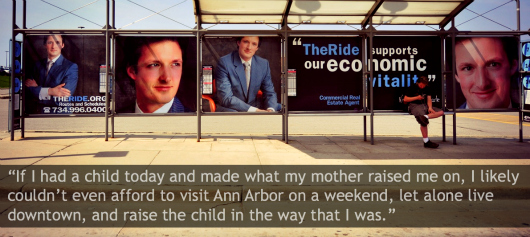
MARK: Let’s start by talking about your childhood. Unlike many of my exit interview subjects, you actually grew up in Ann Arbor…
NEWCOMBE: I was born here, yes, and went through the school system (Mack, Slauson, Pioneer), but my mother took me to India on extended sabbaticals every year through most of my primary school. So I also have a second hometown in Pune, which is about 150 km inland from Mumbai.
MARK: And your parents actually met at the Fleetwood Diner, right? Do you know the circumstances?
 NEWCOMBE: My understanding of the story was that, at the time (somewhere around 1978 or ‘79), my father was working for the late Ned Duke (who owned Mr. Flood’s Party and Leopold Bloom’s, which were located where Grange and West End Grill are today) as a carpenter, bouncer, mechanic, basic jack-of-all trades. My mother, who had known of my father back when she was a waitress at the Gandy Dancer, was, at that point, trying to make it teaching yoga, while she was also tuning and restoring pianos. They apparently met while sitting on the two northernmost stools along the counter at the Fleetwood, when they were in their mid 20s. The marriage lasted a few years in a rented house on Plymouth road, which was razed to make way for a Wendy’s and a carwash (which are still there today). In 1984, my parents separated, and my mother rented her and me a small pink house on North Ashley, seven blocks away from the Fleetwood. For the past nine or so years, I’ve lived in an apartment on Liberty, a half block from the Fleetwood. So I guess, over the past three decades, I haven’t gone far from the late night hippy hash and associated last-call amorous intentions of my origin.
NEWCOMBE: My understanding of the story was that, at the time (somewhere around 1978 or ‘79), my father was working for the late Ned Duke (who owned Mr. Flood’s Party and Leopold Bloom’s, which were located where Grange and West End Grill are today) as a carpenter, bouncer, mechanic, basic jack-of-all trades. My mother, who had known of my father back when she was a waitress at the Gandy Dancer, was, at that point, trying to make it teaching yoga, while she was also tuning and restoring pianos. They apparently met while sitting on the two northernmost stools along the counter at the Fleetwood, when they were in their mid 20s. The marriage lasted a few years in a rented house on Plymouth road, which was razed to make way for a Wendy’s and a carwash (which are still there today). In 1984, my parents separated, and my mother rented her and me a small pink house on North Ashley, seven blocks away from the Fleetwood. For the past nine or so years, I’ve lived in an apartment on Liberty, a half block from the Fleetwood. So I guess, over the past three decades, I haven’t gone far from the late night hippy hash and associated last-call amorous intentions of my origin.
MARK: One of the themes you kept coming back to when I was interviewing you at the Concentrate event was craftsmanship, and your belief that there’s a resurgence in Ann Arbor of people who are thoughtfully making things with their hands, and taking pride in their work. Assuming this is the case, I’m wondering how it can continue, given the ever rising costs associated with living in the City…
NEWCOMBE: It’s a trend that is probably becoming more prevalent everywhere in the western world, post-economic downturn. What was once mass consumption of “design porn” in magazines and Gucci logos on our sticky mats has become a return to, and desire for, the authentic. And, from a business perspective, where there is desire, there are often growth opportunities to market to it. Brooklyn is full of young kids waiting in line for free-range organic brunches and insisting on only wearing denim that has a story. Portlandia makes fun of this trend well. It’s a cultural thing. I’m OK with being caught up with it because it speaks to my own intrinsic motivations.
You’re right, however, that it is still probably a luxury that few in Ann Arbor can afford given the cost of living and the reluctance in the market to pay more for something handcrafted. I’m seeing much more of it here though. Vellum, Mani, Last Word, Babo, Rock Paper Scissors, Mark’s Carts… I’m not sure if these businesses would have made it five years ago because, yes, the rents were higher, and, as a market, we wouldn’t have rewarded them with our business for their slightly higher prices and their uniqueness of offerings.
I remember while growing up my father had a hard go at his carpentry and my mother at her yoga. They still devoted their life to pursuing their craft, and I’m fortunate for being raised under that appreciation for skill and rigor… We could barely pay the bills, however, and for most of that time they had to work other jobs outside their craft to keep me clothed and fed. And that was even when Ann Arbor was more modestly affordable than today.
MARK: Speaking of affordability, you mentioned that your mother bought the home you were raised in for not too much, and that, if it were to sell today, 30 years later, it would likely sell for 6-7 times that, or more… which makes me wonder how life might have been different for you had you been born now. In other words, would you agree that Ann Arbor has become a less viable alternative for single mothers, families on the poverty line, etc? And, assuming you agree, what are the long term consequences of that shift?
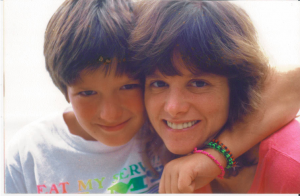 NEWCOMBE: The unique circumstances of my upbringing are very much, I think, a function of Ann Arbor’s history over the past 30 years. It’s not likely a story that can, or should, be repeated in the same way, because my opportunities came with a lot of pain and lack of opportunities for others. Briarwood Mall opens in 1973 because that’s what we culturally wanted to have happen at the time. Also, at that time, if you were poor and/or black you could only often get mortgages in certain neighborhoods, like near North Ashley (now called “Waterhill”) and in Kerrytown. As an aside, I wish we were more honest with ourselves about these facts. Race continues to be something that has shaped most of Michigan for the past 100 years, and Ann Arbor was not immune.
NEWCOMBE: The unique circumstances of my upbringing are very much, I think, a function of Ann Arbor’s history over the past 30 years. It’s not likely a story that can, or should, be repeated in the same way, because my opportunities came with a lot of pain and lack of opportunities for others. Briarwood Mall opens in 1973 because that’s what we culturally wanted to have happen at the time. Also, at that time, if you were poor and/or black you could only often get mortgages in certain neighborhoods, like near North Ashley (now called “Waterhill”) and in Kerrytown. As an aside, I wish we were more honest with ourselves about these facts. Race continues to be something that has shaped most of Michigan for the past 100 years, and Ann Arbor was not immune.
So the mall, and racial steering, bottomed out most of our downtown in the 70s and 80s. They also created opportunities for poor, young 20-somethings to do things downtown, like open a small deli in Kerrytown (1982), a seafood restaurant on Main (1975), save and run a historic movie house (1982), and raise a kid as a single mother on modest means on North Ashley while studying yoga on the side (1984-1999).
We were poor, and we moved into a neighborhood that was cheap. It also happened to be in a neighborhood with a great school system that I could walk to, and a recovering downtown that was my playground. My life is forever changed because of that move of necessity. My childhood was full of art and knowledge and optimism. It made me appreciate a life that was full of possibility, rather than restriction. It made me ambitious. It made me not afraid to take risks.
If I had a child today and made what my mother raised me on, I likely couldn’t even afford to visit Ann Arbor on a weekend, let alone live downtown, and raise the child in the way that I was. The unique opportunity I had, I don’t think can happen again today for those in similar economic situations, without more market manipulation. I’m OK with this, by the way, and I wish we did more of it. I would just rather see us get there this time by subsidizing housing or commercial rents rather than by building more malls or racially steering people to certain neighborhoods.
I don’t know what the long-term consequences of the lack of affordable opportunities are. My guess is it means more people in Washtenaw County that are born into poverty will stay in poverty. They don’t get access to a good school system or access to cheap real estate to start businesses. This translates to more people in need and more money spent for long-term care and extended social benefits. Much more money over a much longer time than it would take to just build more affordable housing and maybe subsidize a dozen or so storefronts today.
MARK: There were two data points that you noted during our conversation that I’d like to have you share here. The first, as I recall, had to do with the greying of the Ann Arbor population. And the second concerned the number of downtown living units that we’d have once all of the construction projects currently underway were completed. Would you mind repeating those here for our readers?
NEWCOMBE: The concentration of 20-35 year olds in Washtenaw County (excluding students, who are not polled as residents) in 1980 (the year I was born) was roughly 50%. When I last checked (2010) they made up less than 7% of the population. Now, it’s not necessarily the case that we have fewer total young people. That number has actually ticked up a few. Rather it’s that while, over the last 30 years, the overall population of Washtenaw doubled, the same demographic balance wasn’t maintained. The net result is that a town that was once balanced, if not dominated (at least from a voting block and commercial market standpoint) by the young, is now overweighed towards the old. Many towns in America have similar demographics today. And, it’s worth noting, none of these towns are doing well today. There’s quite a bit of research on why this is, but most of it boils down to this – cities with lots of young people, who have lots of extra time to work and money to spend, tend to do better.
Growth… and frankly, in America today, if you’re not growing, you’re suffering… has been shown to be only possible with lots of young people of working age and ambition. Technology, being borderless, isn’t a driving factor economically. It’s pure math – when you’re young, you can be more mobile, and you can more easily move to cities that give you the opportunities you require. You take your money and your labor with you to these places. Other demographic groups, with less disposable means, tend to benefit from this migration if it goes towards them. They tend to suffer as it flows elsewhere.
I’m not advocating replacing any older citizen with someone who’s been around the sun less. I’m saying, however, there are consequences for all ages if so little of your total population is 20 to 35 years old.
The other statistic I mentioned was about beds in the DDA boundary, which is what most people consider the measurable boundary of our downtown. Just in the last four to six years alone, that number has gone up close to 7x or 8x. It’s gone from a number around 600 or so, back when we started counting, to approximately 4850 today. And that’s not even including the projects currently under construction. That kind of shift in density in such a small area can have dramatic consequences. Some of these consequences will be quite positive, some perhaps negative. It depends on your viewpoint, I suppose.
Regardless of what happens, fighting change in our downtown is a lost battle. We’re already in the new reality. One or two new buildings, whether they house students, and student-aged people, or not, is not going to reverse what has already changed. Even a half dozen more buildings won’t have the same factor of increase as we’ve seen through the last half-decade – a period, I might add, where most cities in the world, let alone in Michigan, couldn’t pay people to invest in the same way. We’ve been lucky.
MARK: I don’t want to put words in your mouth, but I think it’s safe to say that you don’t count yourself among those who bemoan the loss of “old Ann Arbor,” at least when it comes to retail. Is that correct? (Bonus points if, in your response, you explain why it is that Shaman Drum’s transition into a Five Guys franchise is a good thing for the city.)
 NEWCOMBE: “Old Ann Arbor” may never have existed, at least not in the form people seem so bent on protecting. The reason nostalgia is often effective as an influence tactic (i.e. marketing strategy) is perhaps because it is often free of hard truths. It’s an idealized version of history and we’re often cognitively too lazy or ashamed to be honest about what actually happened.
NEWCOMBE: “Old Ann Arbor” may never have existed, at least not in the form people seem so bent on protecting. The reason nostalgia is often effective as an influence tactic (i.e. marketing strategy) is perhaps because it is often free of hard truths. It’s an idealized version of history and we’re often cognitively too lazy or ashamed to be honest about what actually happened.
Records are a little spotty, but I think the truth is that “Old Ann Arbor” was bought from the Federal Government for about $800 in 1824 by land speculators (i.e. ‘out of town developers’) who kicked out the local Ojibwa. “Old Ann Arbor” was a small village full of poor German immigrants living mainly below the floodplain in shoddily built Sears Roebuck ‘kit’ houses. We were too far from Detroit to be wealthy. (Ironically, Ypsi was the wealth barrier back then too. It was just reversed.) And we were too uneducated to better our circumstances much beyond plowing earth and brewing beer. Our landlords and landowners were wealthy people of British descent, happy to take our rent, but not too excited about increasing our cultural or educational prospects.
Then, in the early 1830s, another group of land speculators cobbled together around 40 acres to the East of the Village of Ann Arbor to try and win the bid for the new state capital. But, when Michigan became a State in January 1837, Lansing became our capital, and those profit-driven speculators sold the land to the State so that they could move the University of Michigan from Detroit. And. Boom. Economic Development. ‘Historic’ houses were razed for bigger houses or apartment buildings (i.e. student housing).
The Irish, Greeks, and Italians smelled the money and came to town wanting to make a life and a living, much to the dismay of the Germans and the Brits over the loss of “Old Ann Arbor”.
Repeat the story over 4 or 5 generations and, then, in the 1960s and 70s, the young and the liberal (my parents), pissed off over Vietnam and other justifiable grievances, move to Ann Arbor to make a life and a living…. much to the dismay of their parents over the loss of “Old Ann Arbor”. And so on, and so on…
What we see today, with all of the anger and frustration on both sides, is regrettable, but it is nothing new. Even the arguments are rehashed. You could probably do a Mad Libs of an old City Council meeting transcript over a controversial project, or an op-ed over the loss of another retailer. Just swap out the names of the projects and the storefronts, and move those that were on the one side 30 years ago to the other today.
As for Five Guys, I’m not a customer myself, but if they offer a good product and do a good job, I’m happy they’ve decided to invest here. If that changes, we’ll get someone new. If Shaman Drum had closed down in any other city in Michigan at the time they would have likely been replaced with an empty storefront.
MARK: In my case, I’d like to think it’s more than just nostalgia. Maybe it’s that I spent so much time in the American Culture program here at U-M, but I fear that we lose something as a culture when we see these big, sweeping changes. And, yes, I appreciate your point about how this is nothing new, but it still pains me to see the record store were Iggy Pop once worked turned into a sub sandwich shop. And, before you say it, yes, I realize that Discount Records was a chain, but, still, I get the feeling that we’re allowing our history to melt away… that we’re trading our communal history for a fast buck. And, once gone, it’s not an easy thing to get back.
NEWCOMBE: I absolutely agree. My guess is that the chain that closed down Discount Records to drive traffic to their new Big Box store south of town would also agree with you today, given how things worked out for them. Same with a certain shuttered national bookstore chain.
When digital changed everything, stores with smaller footprints and knowledgeable staff have resurged as perhaps the only profitable way to deliver content through brick and mortar storefronts. Curation is difficult to commoditize, and a very effective business strategy. And if you or I want to save the culture we think we’re losing, or have lost, spend your money at Literati and Encore rather than online with the river people. We’ve already stopped spending it at Big Box and Borders, mainly out of convenience and price. History, it would seem, is often cheap to evoke, but rarely cheap to protect.
We can blame landlords for killing our downtown, or we can take a look in the mirror, be honest with ourselves, and maybe give the UPS man a break for a week or two… or perhaps even more, honestly. We can stop stealing people’s work online without paying for it at all. Words alone don’t pay the bills. Speak with your wallet. And go shop at places you find value in.
MARK: In your defence of Ann Arbor retail during the Concentrate event, you mentioned the fact that we still have independent stores, like Vault of Midnight, downtown. In the case of Vault of Midnight, though, they have a landlord that buys into their vision, and has priced the space in such a way as to make the store viable. My sense is that those kinds of landlords, who are willing to restrain themselves in a market where that sub sandwich place is on a corner where rents are as high as $60 a square foot, are going to become increasingly more rare. Would you agree?
NEWCOMBE: Over a long enough timeline, vacant storefronts are often always more expensive than maximizing rent with new tenants. Some landlords, and some tenants for that matter, don’t always realize this, or can’t, given their capital structure.
That’s still no excuse for not engaging in best practices as a tenant. Vault has spent a lot of time getting really good at what they do. That’s why they’re successful, not because of their, perhaps lower-than-market, rent. I dropped a ton there last week for product I can just put in my queue for free at the library a few blocks away. Again, they offer not only a product, they offer a service, and a sense of community. I’ll be a customer for life because Curtis will gladly debate Batman’s motivations with me at length. The online river company just tells me what more I should buy. At the library, it’s free, but I’m left to my own poor taste and advice. No thanks.
It depends on what you sell, but to be a sustainable and viable business, real estate expenses should rarely run you more than a ¼ of your revenue. For a low margin business like comic books, it should be lower, much lower. Yes, we as a community could help on subsidizing rent, but, in the meantime, shame on you and your landlord if you’ve thrown best practices out the window and signed a lease at a rent your business can’t afford, even at your most successful.
If you do need some help understanding your numbers and your real estate, make the investment and hire someone who knows what they’re doing, and ideally not someone that is paid more when you spend more. This is why people are mistrustful of real estate professionals, and I understand that. But still, if people stop signing leases at high rents, rents will fall. The fault is communal on this one in my mind.
MARK: In discussing your decision to move, I think you may have offended a few people when you said that people in Ann Arbor don’t have to strive for “excellence”. You said, and I’m obviously paraphrasing here, that you wanted to live in a city, for a change, where only the strong survive, where there are people who you could really learn from. By way of contrast, you painted a portrait of Ann Arbor, where no one excelled because essentially everyone works for the University, and doesn’t have to worry about competition, or where their next meal is coming from. While I appreciate your candor, I was wondering if you might want to modify the statement any, given the fact that you yourself claim to have a great many mentors here in Ann Arbor, who, I would think, would like to believe that they strive to be excellent in their fields.
 NEWCOMBE: Always appreciate the opportunity to remove foot from mouth. My comment was not that we don’t have people here that are excellent, it is that I don’t feel we have a density of people here that are required to strive for excellence in order to survive. Trying to be excellent is a lifelong pursuit in my mind. It’s hard, uncomfortable, stressful, and lonely. People rarely reward you for your efforts. Unless you cannot help yourself, why would you choose that lifestyle if you don’t have to?
NEWCOMBE: Always appreciate the opportunity to remove foot from mouth. My comment was not that we don’t have people here that are excellent, it is that I don’t feel we have a density of people here that are required to strive for excellence in order to survive. Trying to be excellent is a lifelong pursuit in my mind. It’s hard, uncomfortable, stressful, and lonely. People rarely reward you for your efforts. Unless you cannot help yourself, why would you choose that lifestyle if you don’t have to?
For this next phase in my life, I want to be pushed harder by more people in more ways than I think Ann Arbor has the density of experts to do currently. Sure, I could just do it myself without external motivation, but I think, if we’re all being honest, we rarely push ourselves ahead and above unless we feel we have to.
Bannister broke the 4-minute mile only with multiple fresh sprinters on the track to race against. In other cities, more people are either forced to improve by competition (like New York, London, San Francisco) or by ingrained social and cultural norms (Tokyo, Seoul, Paris). Ann Arbor is obviously not a big city like those that I mention… but there’s no reason we can’t all more collectively try to push one another to be better every day… no reason other than the fact that we don’t have to. I’ve been so incredibly fortunate to have mentors in my life, and in this town, that are striving for excellence every day. I just haven’t been able to find a density here moving forward… but I think that’s changing, as I mentioned prior. It will just take time, and I want to selfishly spend the next 30 years of my productive working life being pushed and pulled to be better by many others, rather than finding the strength to do it alone.
MARK: For what it’s worth, having lived in LA and DC, and spent quite a bit of time in New York, I can tell you that not everyone in the cities strives for excellence. I’ll give you that, because of their significantly larger populations, there’s a greater population of individuals doing inspiring work, but I think the notion that everyone there wakes up determined to push the envelope in incredible ways, as I think you suggested during our interview for Concentrate, is overstating it a bit.
NEWCOMBE: Absolutely. It’s not everyone in any market, but I think it’s a higher density in certain places, and in certain fields. Especially (I hope) in the particular city and profession I’ll be in. I don’t want to put words in your mouth but you’re kind of making my point if you’re saying that only big cities can get the best because they’re big. They’re big, perhaps, because they have the best. They continue to attract the best because they’re big. So, and not to create a paradox here, but if you claim to be excellent in a city which is densely excellent, you are therefor not in a small city. If you are in a small city, you’re then therefore, not excellent. This I don’t believe to be true necessarily, but I do believe that I’m not alone in being attracted to the presence and possibility of excellence. This attraction grows cities. If Ann Arbor was full of excellent people, you couldn’t stop the growth. Incredibly smart and ambitious people would claw their way to be here, growing our city exponentially… and yet our population growth is tepid, if not stagnant.
If, say, in one of the big cities we mentioned above, there is a generous estimation that 4 of 10 push themselves towards excellence over a meaningful period, those that don’t may get selected out over a year or two.
Not all those that move back to Michigan do so just because family is a big draw. I don’t know a lot of people my age or older who quit highly successful, meaningful careers to return home by choice. If returning to Ann Arbor meant the same level of competition and rigor, I’m not sure they would rush back. This is anecdotal, but many of those I know that have come back from my generation find it a much easier time here… and they’re not all terribly proud or satisfied about being back so soon to a life that is less challenging.
Life in Ann Arbor is fantastic. I want to be very clear about that. I’m not sure however that I will achieve the level of rigor and excellence I want for myself if I stay through the next period of my live. I’m rather certain, however, I’ll have a better shot if I do it in a professional and social environment that puts more of a requirement on it. Again, this is not a size thing for me. Small cities have always been my preference personally. I’m just trapped in a paradox of wanting to believe we’re ALL smart and excellent in Ann Arbor, but not having the logical justification to back that claim.
MARK: How do you respond to those who would say that you should stay and fight to make this community a better place, instead of leaving for a community where things are already somewhat established? Which I think goes back to your point about excellence. How do we build a culture of excellence, when those who care about such things are always leaving.
NEWCOMBE: My point above. I can spend the next 30 years fighting here, sure. A quick web search will show I did spend the last 10 year fighting for the things I think we need. All I can say is the prospect of always being the first through the door can leave you exhausted and full of bullet holes. This City wants to be better, it just doesn’t always want anybody to do it. Because better means different, and different means change, and change is scary, when the here and now isn’t all that bad.
We’ve lost dozens of fighters over the past six years. You’ve interviewed a lot of them. People much smarter, harder working, and more likable than me. They’ve gone to cities that don’t want or need them to fight to improve their surroundings. And, as much as they loved Ann Arbor, and as hard as they fought to make her better, they are much happier not having to fight for a while.
MARK: As many of my readers know, you waged an unsuccessful independent bid for Ann Arbor City Council not too long ago. I’m curious as to how your view of the city, and its inhabitants, changed as a result of this experience.
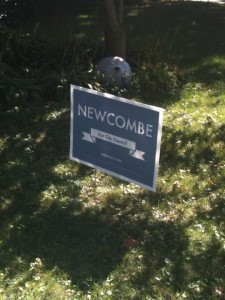 NEWCOMBE: My view has changed for the better, absolutely. I had some very particular goals I wanted to accomplish with my campaign — being elected and serving my term was only one of them… and not very high on my list, if I’m being honest. Also, I don’t know who said it, but I believe in the wisdom of the old saying that everyone should run for office at least once in their life.
NEWCOMBE: My view has changed for the better, absolutely. I had some very particular goals I wanted to accomplish with my campaign — being elected and serving my term was only one of them… and not very high on my list, if I’m being honest. Also, I don’t know who said it, but I believe in the wisdom of the old saying that everyone should run for office at least once in their life.
I’m much more aware of my own impatience at times after the run. And, subsequently, I’m much more able to understand when it can be an effective or harmful influence. I got a lot of great advice from very smart people during the campaign. The one thing that stuck with me most was that, at any given time, there is a limited range of possibilities of what people will tolerate. You can’t change too much too fast and get ahead of the voters, nor can you do too little too slow and fall behind the curve. To be successful in the long term (and/or to avoid being tossed out of office) you need to stay in that range and avoid pushing the margins too much. If, however, you want to widen the margins, you can, but you will likely fall on your sword for doing so. The question posed to me by this particular mentor was, “Which result are you trying to create?”
I suppose, at the time, I wanted to push the margins wider more than I wanted a successful political career. If I ended up doing that, and in some ways I think I did, I’m happy with the outcome. There was certainly a price to pay for it. As such, I realize now that it was a choice I made rather than one that was forced on me out of fiduciary to boards or clients of mine or necessity of my circumstances. I’ve always loved Ann Arbor and her citizens. Post-election, I also now have much less judgmental blame or doubt in our collective actions and abilities. We, in this community at any given point, have a collective margin of tolerance. If any of us don’t like this margin, we each have a choice: push it, or move. That’s on us individually, and is not Ann Arbor’s fault. “I love you, now change,” isn’t fair to anyone. And knowing that is different for me now, post campaign.
MARK: Speaking of politics, did Michigan politics play a role in your decision? Or, to put it another way, is it easier to leave a state that’s doing things like forcing through anti-union “right to work” legislation, defunding Planned Parenthood, stripping domestic partner benefits from gay state employees, seeking to protect healthcare workers who don’t want to serve gay patients, instituting Emergency Managers, and the like?
NEWCOMBE: I’m not happy about any of the above. I am very much my parent’s son after all. There isn’t, however, a state that I know of that gets everything right for me. If I had a goal for Michigan, I would like us to just shoot for the middle for a few years. Being best in education will take incredible investment and likely sacrifices we don’t want to make short term. As would being “first” in weakening the Unions. Michigan as a state is probably far from where I would want us to be long term personally. But I don’t own property, don’t have kids, and I’m a young and healthy, well-educated white man. Personally, I’m not terribly at risk from backward political thinking anytime soon. It’s convenient for me to shake my head at some of what comes out of Lansing that I hear on the radio each morning, but it doesn’t really affect me yet. This will likely change as my situation does, but it isn’t enough to compel me to move or stay at this point. I could do more, sure, but again, I’m not in the fighting mood for the next 30 years.
MARK: As you mentioned at the Concentrate event, Ann Arbor is already changing as a result of the increasing density downtown. You noted, for instance, that Babo likely wouldn’t have been possible even a few short years ago. Given that you made your living as a commercial real estate broker prior to going back to U-M for your MBA, I’m wondering if you have thoughts as to other opportunities that might arise as a result of this increasing downtown population.
NEWCOMBE: Ironically, the things most people say they miss downtown (e.g. bookstores, markets, even a soda fountain here or there) are more possible with more density. To return to the past, we have to allow the change to the future. As I mentioned, the global reality of a free market is that to even maintain, let alone thrive, you have to grow. If you just absolutely hate the idea of a half dozen towers full of college students, try and remember that the U isn’t growing that quickly in terms of student population; in fact, some colleges and schools in the system are shrinking to maintain rankings and competitiveness. Stagnant or shrinking overall student population and more student housing on less land downtown means that those red-cupped partiers are going to be sucked out of the neighborhoods.
This can create more pressure for landlords to improve the existing housing stock and/or lower rent. If they don’t, they’ll have to sell it to others at a discount, thereby creating opportunities for young families and/or people of more modest means to move close to downtown. You want to create more affordable housing and not use tax dollars to do it, allow more dense housing to be built. It’s a net win for everyone as I see it. Stronger neighborhoods, more diverse downtown shopping and service options, less use of city services per capita—It’s a total win… unless, of course, you own existing student rentals and/or live directly next to these new buildings… which most of those protesting actually check both boxes off on.
MARK: If you had to do it all over again, would you have used your time here differently?
NEWCOMBE: Yes. I would have gotten rid of my car ten years ago. Best decision of my life. I’ll never live or work anywhere that can’t affordably and reliable get me to the office, a gym, a market, the airport, and the train station without public transportation ever again. Ann Arbor transportation isn’t perfect, but it’s by far the best in the Michigan in providing this. I waited way too long to get rid of my car. Other than that, I’ve had an incredibly blessed life here. I am equally thankful for all the mistakes and failures I’ve made along the way as I am for the successes. I wouldn’t change a thing… other than getting rid of the car.
MARK: I have no idea how old this footage of you talking about how Ann Arbor is a microcosm of Portland and Rotterdam is, but I’m wondering how you might state things differently, if interviewed today.
 NEWCOMBE: That footage is about three or four years old, I think. Part of a Public Broadcasting series on what’s great about cities in Michigan. I think it’s called Under the Radar. Great, positive show and worth checking out.
NEWCOMBE: That footage is about three or four years old, I think. Part of a Public Broadcasting series on what’s great about cities in Michigan. I think it’s called Under the Radar. Great, positive show and worth checking out.
The interview was right before I started B-School, which ultimately was the beginning of what is pulling me out of Michigan now. I’ve spent most of my young professional life working hard, and being optimistic about how great Michigan and Ann Arbor is, and could be. My efforts had the knock-on effect of also getting me a lot of attention and accolades. That attention, along with the hard work, and a ton of luck, allowed me to be professionally successful in my previous real estate and consulting career.
I perhaps cashed in too much of that social and political capital when I “pushed the margins” with my development projects, and the campaign. My messaging, however, has stayed pretty consistent throughout, and I stand by that clip. Truth is, I’ve now got this really expensive degree and a great opportunity to test it. That opportunity, and ones like it, is not yet unfortunately in Michigan in abundance. Signs look rosy that there will be more to come in the future, and I look forward to seeing how that will play out. It will then just likely be an older me in the stands, excited for the those that are stepping up to the plate… rather than me standing there myself to swing at bat.
MARK: What would the ideal job be for Newcombe Clark?
NEWCOMBE: I, of course, have high hopes my new job will be satisfying in all the ways I’ve outlined in this interview. I care deeply about how people interact with their social environment. I’m curious about why we make the decisions we do. What we spend our time and money on, where we go to spend it, and why. This, in the past, included focusing on place-making through real estate and community and arts involvement. Moving forward with my career there will likely be more of a focus on building international businesses and brands through product and service innovation and other related growth strategies.
In more plain speak perhaps, I like solving puzzles more than I like solving problems. My new firm works with clients that are trying to find ways to grow and better service their customers through what they sell and how. Other firms I considered (and quickly eliminated as a poor fit) are more often tasked with coming up with solutions to crisis or hardship. Downsizing and the like. That’s not for me. You may be the best surgeon in the world, but that rarely means people will call you up and say, “Hey Doc, feeling great. Can you cut me open?” It’s certainly noble work to heal what’s sick and fix what’s broken. Emotionally, however, I don’t want to apply whatever skill I may have to being around pain all the time.
Now, if for some reason this new job isn’t everything I hope it’s going to be (or if I’m not everything they’re hoping I am), I’ll have to reassess. I think however there will be a consistent intrinsic motivation to continue to develop a craft. It’s how my parents raised me, and it’s something that I value. As such, it doesn’t much matter what the job is, or what I make doing it, as long as I can meaningfully apply myself everyday to getting better at what I do, and how I do it. This, to me, is how I can regard myself with honor and live a life of purpose and meaning.
MARK: What are the odds that you’ll be back?
NEWCOMBE: I suspect that once I cut anchor I won’t necessarily call any particular place home again as much as I did Ann Arbor. The life I currently want and envision myself leading is a bit less tied to any particular geography or culture. To do well at my chosen profession I don’t think it can be. But, I’m still just 32 and I could be back in six months. The only thing I know for certain at this age is that what I still don’t know vastly outweighs the little I do.
[For your further enjoyment: Here are links to video of my live exit interview with Newcombe, and the MarkMaynard.com exit interview archive.]




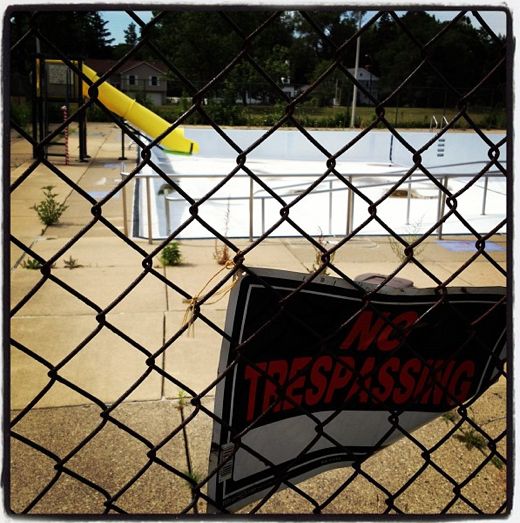
 MARK: How many people use the pool each day?
MARK: How many people use the pool each day?
 NEWCOMBE: My understanding of the story was that, at the time (somewhere around 1978 or ‘79), my father was working for the late
NEWCOMBE: My understanding of the story was that, at the time (somewhere around 1978 or ‘79), my father was working for the late  NEWCOMBE: The unique circumstances of my upbringing are very much, I think, a function of Ann Arbor’s history over the past 30 years. It’s not likely a story that can, or should, be repeated in the same way, because my opportunities came with a lot of pain and lack of opportunities for others. Briarwood Mall opens in 1973 because that’s what we culturally wanted to have happen at the time. Also, at that time, if you were poor and/or black you could only often get mortgages in certain neighborhoods, like near North Ashley (now called “Waterhill”) and in Kerrytown. As an aside, I wish we were more honest with ourselves about these facts. Race continues to be something that has shaped most of Michigan for the past 100 years, and Ann Arbor was not immune.
NEWCOMBE: The unique circumstances of my upbringing are very much, I think, a function of Ann Arbor’s history over the past 30 years. It’s not likely a story that can, or should, be repeated in the same way, because my opportunities came with a lot of pain and lack of opportunities for others. Briarwood Mall opens in 1973 because that’s what we culturally wanted to have happen at the time. Also, at that time, if you were poor and/or black you could only often get mortgages in certain neighborhoods, like near North Ashley (now called “Waterhill”) and in Kerrytown. As an aside, I wish we were more honest with ourselves about these facts. Race continues to be something that has shaped most of Michigan for the past 100 years, and Ann Arbor was not immune. NEWCOMBE: “Old Ann Arbor” may never have existed, at least not in the form people seem so bent on protecting. The reason nostalgia is often effective as an influence tactic (i.e. marketing strategy) is perhaps because it is often free of hard truths. It’s an idealized version of history and we’re often cognitively too lazy or ashamed to be honest about what actually happened.
NEWCOMBE: “Old Ann Arbor” may never have existed, at least not in the form people seem so bent on protecting. The reason nostalgia is often effective as an influence tactic (i.e. marketing strategy) is perhaps because it is often free of hard truths. It’s an idealized version of history and we’re often cognitively too lazy or ashamed to be honest about what actually happened. NEWCOMBE: Always appreciate the opportunity to remove foot from mouth. My comment was not that we don’t have people here that are excellent, it is that I don’t feel we have a density of people here that are required to strive for excellence in order to survive. Trying to be excellent is a lifelong pursuit in my mind. It’s hard, uncomfortable, stressful, and lonely. People rarely reward you for your efforts. Unless you cannot help yourself, why would you choose that lifestyle if you don’t have to?
NEWCOMBE: Always appreciate the opportunity to remove foot from mouth. My comment was not that we don’t have people here that are excellent, it is that I don’t feel we have a density of people here that are required to strive for excellence in order to survive. Trying to be excellent is a lifelong pursuit in my mind. It’s hard, uncomfortable, stressful, and lonely. People rarely reward you for your efforts. Unless you cannot help yourself, why would you choose that lifestyle if you don’t have to? NEWCOMBE: My view has changed for the better, absolutely. I had some very particular goals I wanted to accomplish with my campaign — being elected and serving my term was only one of them… and not very high on my list, if I’m being honest. Also, I don’t know who said it, but I believe in the wisdom of the old saying that everyone should run for office at least once in their life.
NEWCOMBE: My view has changed for the better, absolutely. I had some very particular goals I wanted to accomplish with my campaign — being elected and serving my term was only one of them… and not very high on my list, if I’m being honest. Also, I don’t know who said it, but I believe in the wisdom of the old saying that everyone should run for office at least once in their life. NEWCOMBE: That footage is about three or four years old, I think. Part of a Public Broadcasting series on what’s great about cities in Michigan. I think it’s called
NEWCOMBE: That footage is about three or four years old, I think. Part of a Public Broadcasting series on what’s great about cities in Michigan. I think it’s called 
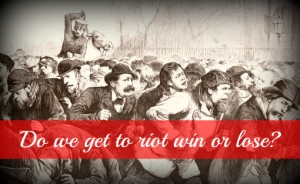 One question: Will there be a riot tonight regardless of the game’s outcome? I’m not up to speed on American riot etiquette. And, if there is a riot, what form will it take? Will couches all over the City be pulled into the streets and set aflame, or will everyone come together in one place to tip news vans on their sides?
One question: Will there be a riot tonight regardless of the game’s outcome? I’m not up to speed on American riot etiquette. And, if there is a riot, what form will it take? Will couches all over the City be pulled into the streets and set aflame, or will everyone come together in one place to tip news vans on their sides? 









